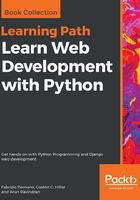
The break and continue statements
According to the task at hand, sometimes you will need to alter the regular flow of a loop. You can either skip a single iteration (as many times as you want), or you can break out of the loop entirely. A common use case for skipping iterations is, for example, when you're iterating over a list of items and you need to work on each of them only if some condition is verified. On the other hand, if you're iterating over a collection of items, and you have found one of them that satisfies some need you have, you may decide not to continue the loop entirely and therefore break out of it. There are countless possible scenarios, so it's better to see a couple of examples.
Let's say you want to apply a 20% discount to all products in a basket list for those that have an expiration date of today. The way you achieve this is to use the continue statement, which tells the looping construct (for or while) to stop execution of the body immediately and go to the next iteration, if any. This example will take us a little deeper down the rabbit hole, so be ready to jump:
# discount.py
from datetime import date, timedelta
today = date.today()
tomorrow = today + timedelta(days=1) # today + 1 day is tomorrow
products = [
{'sku': '1', 'expiration_date': today, 'price': 100.0},
{'sku': '2', 'expiration_date': tomorrow, 'price': 50},
{'sku': '3', 'expiration_date': today, 'price': 20},
]
for product in products:
if product['expiration_date'] != today:
continue
product['price'] *= 0.8 # equivalent to applying 20% discount
print(
'Price for sku', product['sku'],
'is now', product['price'])
We start by importing the date and timedelta objects, then we set up our products. Those with sku as 1 and 3 have an expiration date of today, which means we want to apply a 20% discount on them. We loop over each product and we inspect the expiration date. If it is not (inequality operator, !=) today, we don't want to execute the rest of the body suite, so we continue.
Notice that it is not important where in the body suite you place the continue statement (you can even use it more than once). When you reach it, execution stops and goes back to the next iteration. If we run the discount.py module, this is the output:
$ python discount.py
Price for sku 1 is now 80.0
Price for sku 3 is now 16.0
This shows you that the last two lines of the body haven't been executed for sku number 2.
Let's now see an example of breaking out of a loop. Say we want to tell whether at least one of the elements in a list evaluates to True when fed to the bool function. Given that we need to know whether there is at least one, when we find it, we don't need to keep scanning the list any further. In Python code, this translates to using the break statement. Let's write this down into code:
# any.py
items = [0, None, 0.0, True, 0, 7] # True and 7 evaluate to True
found = False # this is called "flag"
for item in items:
print('scanning item', item)
if item:
found = True # we update the flag
break
if found: # we inspect the flag
print('At least one item evaluates to True')
else:
print('All items evaluate to False')
The preceding code is such a common pattern in programming, you will see it a lot. When you inspect items this way, basically what you do is to set up a flag variable, then start the inspection. If you find one element that matches your criteria (in this example, that evaluates to True), then you update the flag and stop iterating. After iteration, you inspect the flag and take action accordingly. Execution yields:
$ python any.py
scanning item 0
scanning item None
scanning item 0.0
scanning item True
At least one item evaluates to True
See how execution stopped after True was found? The break statement acts exactly like the continue one, in that it stops executing the body of the loop immediately, but also, prevents any other iteration from running, effectively breaking out of the loop. The continue and break statements can be used together with no limitation in their numbers, both in the for and while looping constructs.